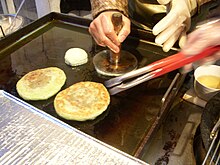| Revision as of 19:18, 21 April 2008 editKbdankbot (talk | contribs)184,258 editsm Robot - remove category per CFD 2008 April 12← Previous edit | Revision as of 19:43, 21 April 2008 edit undoBadagnani (talk | contribs)136,593 edits category should have been subsitutedNext edit → | ||
| Line 27: | Line 27: | ||
| ] | ] | ||
| ] | ] | ||
| ] | |||
Revision as of 19:43, 21 April 2008
| Hotteok | |
 | |
| Korean name | |
|---|---|
| Hangul | 호떡 |
| Revised Romanization | ho ddeok |
| McCune–Reischauer | ho ttŏk |
Ho-tteok is a popular street food of South Korea and is similar to pancakes. It is made of wheat flour dough with fillings and baked on the sizzling plate. It is believed that ho-tteok originated from Chinese merchants who immigrated to Korea after the late 19th century. Unlike Chinese rice cakes containing savory meat fillings, ho-tteok is stuffed with sweet fillings such as brown sugar, honey, chopped peanuts, and cinnamon to suit Koreans' tastes. Ho-tteok is usually eaten during the winter season.
Varieties
The types of hotteok have been changing continuously. In recent years, however, new variations have developed - one of them is the well-being hotteok. Its dough contains green tea powder so it becomes greenish after baking. Another variety is pink hotteok. Its dough contains added berries, such as Rubus coreanus (a raspberry-like berry that is also used to make Korean berry wine).
Nutrition
Hotteok is usually eaten during the winter season but it is not recommended to overindulge due its high sugar content; a single hotteok may have as many as 230 calories.
See also
Reference
- 겨울철에 약이되는음식& 독이되는음식 kukinews 2007.01.07
External links
- Simple info and photo of ho-tteok
- Article about the origin of Ho-tteok and Hobbang] "'겨울철 양대 간식' 호빵과 호떡의 넋두리" (in Korean)